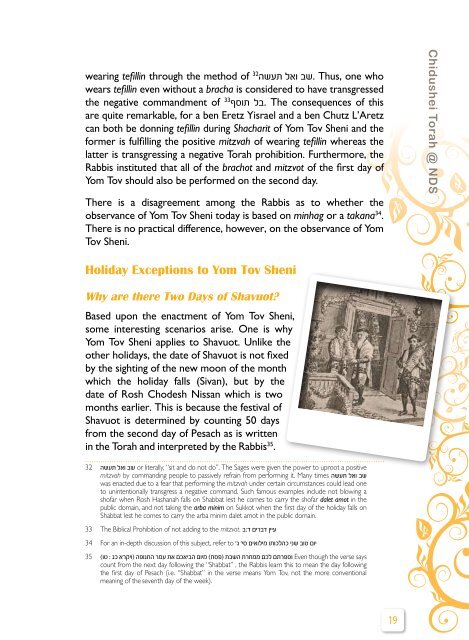Y om T o v Sheni Yom Tov Sheni - Chidushei Torah@NDS
Y om T o v Sheni Yom Tov Sheni - Chidushei Torah@NDS
Y om T o v Sheni Yom Tov Sheni - Chidushei Torah@NDS
Create successful ePaper yourself
Turn your PDF publications into a flip-book with our unique Google optimized e-Paper software.
wearing tefillin through the method of 32 השעת לאו בש. Thus, one who<br />
wears tefillin even without a bracha is considered to have transgressed<br />
the negative c<strong>om</strong>mandment of 33 ףסות לב. The consequences of this<br />
are quite remarkable, for a ben Eretz Yisrael and a ben Chutz L’Aretz<br />
can both be donning tefillin during Shacharit of Y<strong>om</strong> <strong>Tov</strong> <strong>Sheni</strong> and the<br />
former is fulfilling the positive mitzvah of wearing tefillin whereas the<br />
latter is transgressing a negative Torah prohibition. Furthermore, the<br />
Rabbis instituted that all of the brachot and mitzvot of the first day of<br />
Y<strong>om</strong> <strong>Tov</strong> should also be performed on the second day.<br />
There is a disagreement among the Rabbis as to whether the<br />
observance of Y<strong>om</strong> <strong>Tov</strong> <strong>Sheni</strong> today is based on minhag or a takana 34 .<br />
There is no practical difference, however, on the observance of Y<strong>om</strong><br />
<strong>Tov</strong> <strong>Sheni</strong>.<br />
Holiday Exceptions to Y<strong>om</strong> <strong>Tov</strong> <strong>Sheni</strong><br />
Why are there Two Days of Shavuot?<br />
Based upon the enactment of Y<strong>om</strong> <strong>Tov</strong> <strong>Sheni</strong>,<br />
s<strong>om</strong>e interesting scenarios arise. One is why<br />
Y<strong>om</strong> <strong>Tov</strong> <strong>Sheni</strong> applies to Shavuot. Unlike the<br />
other holidays, the date of Shavuot is not fixed<br />
by the sighting of the new moon of the month<br />
which the holiday falls (Sivan), but by the<br />
date of Rosh Chodesh Nissan which is two<br />
months earlier. This is because the festival of<br />
Shavuot is determined by counting 50 days<br />
fr<strong>om</strong> the second day of Pesach as is written<br />
in the Torah and interpreted by the Rabbis 35 .<br />
32 השעת לאו בש or literally, “sit and do not do”. The Sages were given the power to uproot a positive<br />
mitzvah by c<strong>om</strong>manding people to passively refrain fr<strong>om</strong> performing it. Many times השעת לאו בש<br />
was enacted due to a fear that performing the mitzvah under certain circumstances could lead one<br />
to unintentionally transgress a negative c<strong>om</strong>mand. Such famous examples include not blowing a<br />
shofar when Rosh Hashanah falls on Shabbat lest he c<strong>om</strong>es to carry the shofar dalet amot in the<br />
public d<strong>om</strong>ain, and not taking the arba minim on Sukkot when the first day of the holiday falls on<br />
Shabbat lest he c<strong>om</strong>es to carry the arba minim dalet amot in the public d<strong>om</strong>ain.<br />
33 The Biblical Prohibition of not adding to the mitzvot. ב:ד םירבד ןייע<br />
34 For an in-depth discussion of this subject, refer to ’ג ’יס םיאולימ ותוכלהכ ינש בוט םוי<br />
35 )וט : גכ ארקיו( הפונתה רמע תא םכאיבה םוימ )חספ( תבשה תרחממ םכל םתרפסו Even though the verse says<br />
count fr<strong>om</strong> the next day following the “Shabbat” , the Rabbis learn this to mean the day following<br />
the first day of Pesach (i.e. “Shabbat” in the verse means Y<strong>om</strong> <strong>Tov</strong>, not the more conventional<br />
meaning of the seventh day of the week).<br />
19<br />
<strong>Chidushei</strong> Torah @ NDS


